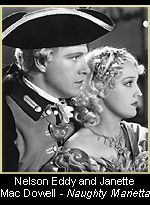
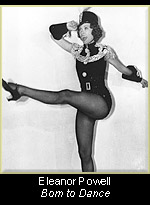 By 1930, the musical was dead in Hollywood. Too many had been seen in 1928 and 1929. They were reflections of the times prior to the economic crash. However, the perfected use of sound, camera tracking and boom mikes brought new life to the genre. All-star reviews, Broadway adaptations and the backstage story were perfect vehicles for musicals.. Warner's was the first to revive the elaborate musical in 1933. The studio released 42nd Street, Golddiggers of 1933 and Footlight Parade, made with original and creative production numbers. Their stories realistically reflected contemporary America. The pictures were alive with music, chorus girls and sex. Berkeley's distinctive camera work included overhead and traveling shots and stark black and white and geometric patterned dance numbers. The stock players included Ginger Rogers, Joan Blondell, Ruby Keeler, and Dick Powell plus James Cagney in Footlight Parade. MGM was also a contender for musicals during the decade. A series of films with Jeanette MacDonald and Nelson Eddy had great appeal for lovers of light opera. They included Naughty Marietta, Sweethearts, Maytime and Rose Marie and were recognized as quality pictures. Eleanor Powell's tap dancing combined with grace from her ballet work won her starring parts in movies. Broadway Melody of 1936, Born to Dance and Broadway Melody of 1938 were unsurpassed. The production numbers were brilliantly conceived and executed by a genuine trooper.. The story values were thin but a wide array of supporting players were used including Buddy Ebsen, Phil Silvers, Jack Benny, Sophie Tucker and a very young Judy Garland.
By 1930, the musical was dead in Hollywood. Too many had been seen in 1928 and 1929. They were reflections of the times prior to the economic crash. However, the perfected use of sound, camera tracking and boom mikes brought new life to the genre. All-star reviews, Broadway adaptations and the backstage story were perfect vehicles for musicals.. Warner's was the first to revive the elaborate musical in 1933. The studio released 42nd Street, Golddiggers of 1933 and Footlight Parade, made with original and creative production numbers. Their stories realistically reflected contemporary America. The pictures were alive with music, chorus girls and sex. Berkeley's distinctive camera work included overhead and traveling shots and stark black and white and geometric patterned dance numbers. The stock players included Ginger Rogers, Joan Blondell, Ruby Keeler, and Dick Powell plus James Cagney in Footlight Parade. MGM was also a contender for musicals during the decade. A series of films with Jeanette MacDonald and Nelson Eddy had great appeal for lovers of light opera. They included Naughty Marietta, Sweethearts, Maytime and Rose Marie and were recognized as quality pictures. Eleanor Powell's tap dancing combined with grace from her ballet work won her starring parts in movies. Broadway Melody of 1936, Born to Dance and Broadway Melody of 1938 were unsurpassed. The production numbers were brilliantly conceived and executed by a genuine trooper.. The story values were thin but a wide array of supporting players were used including Buddy Ebsen, Phil Silvers, Jack Benny, Sophie Tucker and a very young Judy Garland.
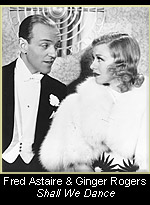 Fred and Ginger...no other names were necessary for these two who appeared to dance on air in the triumphant musicals made by R.K.O. Ginger Rogers was already known to audiences from her earlier work in 42nd Street and Golddiggers of 1933. They danced to music by such American composers as Irving Berlin, George Gershwin, Jerome Kern and Cole Porter among others. They were a sensation from the beginning of their collaboration. Much of their effortless partnering was due to the dance genius of Fred Astaire. Of their nine films, Top Hat and Swing Time were the American favorites.
Fred and Ginger...no other names were necessary for these two who appeared to dance on air in the triumphant musicals made by R.K.O. Ginger Rogers was already known to audiences from her earlier work in 42nd Street and Golddiggers of 1933. They danced to music by such American composers as Irving Berlin, George Gershwin, Jerome Kern and Cole Porter among others. They were a sensation from the beginning of their collaboration. Much of their effortless partnering was due to the dance genius of Fred Astaire. Of their nine films, Top Hat and Swing Time were the American favorites.

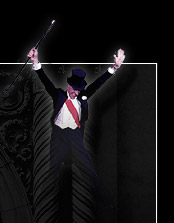
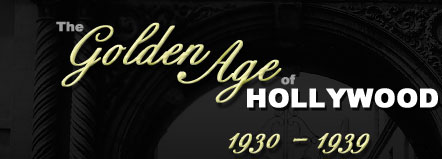

 By 1930, the musical was dead in Hollywood. Too many had been seen in 1928 and 1929. They were reflections of the times prior to the economic crash. However, the perfected use of sound, camera tracking and boom mikes brought new life to the genre. All-star reviews, Broadway adaptations and the backstage story were perfect vehicles for musicals.. Warner's was the first to revive the elaborate musical in 1933. The studio released 42nd Street, Golddiggers of 1933 and Footlight Parade, made with original and creative production numbers. Their stories realistically reflected contemporary America. The pictures were alive with music, chorus girls and sex. Berkeley's distinctive camera work included overhead and traveling shots and stark black and white and geometric patterned dance numbers. The stock players included Ginger Rogers, Joan Blondell, Ruby Keeler, and Dick Powell plus James Cagney in Footlight Parade. MGM was also a contender for musicals during the decade. A series of films with Jeanette MacDonald and Nelson Eddy had great appeal for lovers of light opera. They included Naughty Marietta, Sweethearts, Maytime and Rose Marie and were recognized as quality pictures. Eleanor Powell's tap dancing combined with grace from her ballet work won her starring parts in movies. Broadway Melody of 1936, Born to Dance and Broadway Melody of 1938 were unsurpassed. The production numbers were brilliantly conceived and executed by a genuine trooper.. The story values were thin but a wide array of supporting players were used including Buddy Ebsen, Phil Silvers, Jack Benny, Sophie Tucker and a very young Judy Garland.
By 1930, the musical was dead in Hollywood. Too many had been seen in 1928 and 1929. They were reflections of the times prior to the economic crash. However, the perfected use of sound, camera tracking and boom mikes brought new life to the genre. All-star reviews, Broadway adaptations and the backstage story were perfect vehicles for musicals.. Warner's was the first to revive the elaborate musical in 1933. The studio released 42nd Street, Golddiggers of 1933 and Footlight Parade, made with original and creative production numbers. Their stories realistically reflected contemporary America. The pictures were alive with music, chorus girls and sex. Berkeley's distinctive camera work included overhead and traveling shots and stark black and white and geometric patterned dance numbers. The stock players included Ginger Rogers, Joan Blondell, Ruby Keeler, and Dick Powell plus James Cagney in Footlight Parade. MGM was also a contender for musicals during the decade. A series of films with Jeanette MacDonald and Nelson Eddy had great appeal for lovers of light opera. They included Naughty Marietta, Sweethearts, Maytime and Rose Marie and were recognized as quality pictures. Eleanor Powell's tap dancing combined with grace from her ballet work won her starring parts in movies. Broadway Melody of 1936, Born to Dance and Broadway Melody of 1938 were unsurpassed. The production numbers were brilliantly conceived and executed by a genuine trooper.. The story values were thin but a wide array of supporting players were used including Buddy Ebsen, Phil Silvers, Jack Benny, Sophie Tucker and a very young Judy Garland.
 Fred and Ginger...no other names were necessary for these two who appeared to dance on air in the triumphant musicals made by R.K.O. Ginger Rogers was already known to audiences from her earlier work in 42nd Street and Golddiggers of 1933. They danced to music by such American composers as Irving Berlin, George Gershwin, Jerome Kern and Cole Porter among others. They were a sensation from the beginning of their collaboration. Much of their effortless partnering was due to the dance genius of Fred Astaire. Of their nine films, Top Hat and Swing Time were the American favorites.
Fred and Ginger...no other names were necessary for these two who appeared to dance on air in the triumphant musicals made by R.K.O. Ginger Rogers was already known to audiences from her earlier work in 42nd Street and Golddiggers of 1933. They danced to music by such American composers as Irving Berlin, George Gershwin, Jerome Kern and Cole Porter among others. They were a sensation from the beginning of their collaboration. Much of their effortless partnering was due to the dance genius of Fred Astaire. Of their nine films, Top Hat and Swing Time were the American favorites.